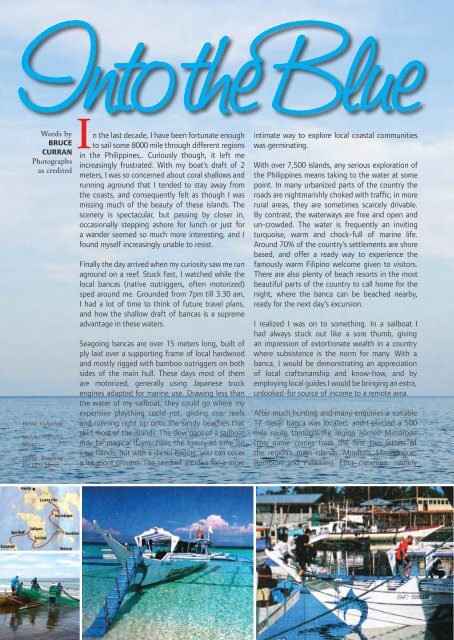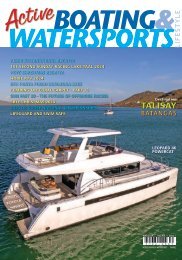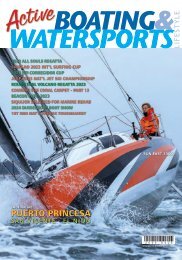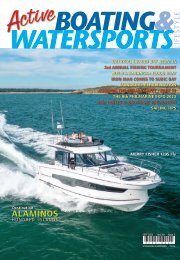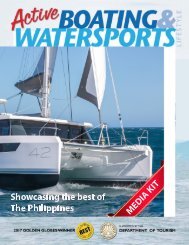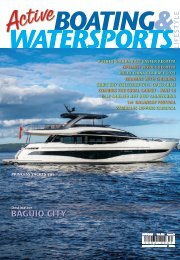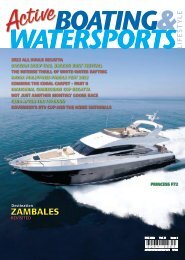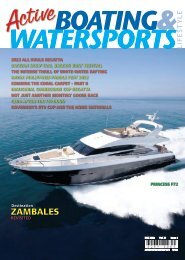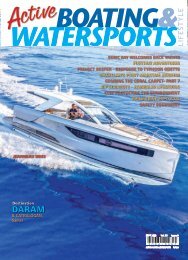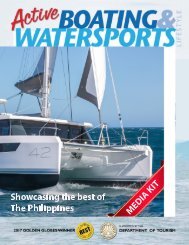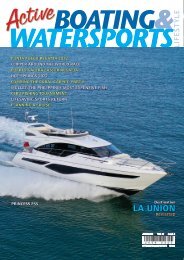ABW Sept 2018-1
Create successful ePaper yourself
Turn your PDF publications into a flip-book with our unique Google optimized e-Paper software.
Words by<br />
BRUCE<br />
CURRAN<br />
Photographs<br />
as credited<br />
Below: Fisherfolk<br />
Middle: The Lenz<br />
Meret<br />
Center: Boarding<br />
the Lenz Meret<br />
I<br />
n the last decade, I have been fortunate enough<br />
to sail some 8000 mile through different regions<br />
in the Philippines,. Curiously though, it left me<br />
increasingly frustrated. With my boat’s draft of 2<br />
meters, I was so concerned about coral shallows and<br />
running aground that I tended to stay away from<br />
the coasts, and consequently felt as though I was<br />
missing much of the beauty of these islands. The<br />
scenery is spectacular, but passing by closer in,<br />
occasionally stepping ashore for lunch or just for<br />
a wander seemed so much more interesting, and I<br />
found myself increasingly unable to resist.<br />
Finally the day arrived when my curiosity saw me run<br />
aground on a reef. Stuck fast, I watched while the<br />
local bancas (native outriggers, often motorized)<br />
sped around me. Grounded from 7pm till 3.30 am,<br />
I had a lot of time to think of future travel plans,<br />
and how the shallow draft of bancas is a supreme<br />
advantage in these waters.<br />
Seagoing bancas are over 15 meters long, built of<br />
ply laid over a supporting frame of local hardwood<br />
and mostly rigged with bamboo outriggers on both<br />
sides of the main hull. These days most of them<br />
are motorized, generally using Japanese truck<br />
engines adapted for marine use. Drawing less than<br />
the water of my sailboat, they could go where my<br />
expensive plaything could not, gliding over reefs<br />
and running right up onto the sandy beaches that<br />
skirt most of the islands. The slow pace of a sailboat<br />
may be magical if you have the luxury of time on<br />
your hands, but with a diesel engine, you can cover<br />
a lot more ground. The seed of an idea for a more<br />
intimate way to explore local coastal communities<br />
was germinating.<br />
With over 7,500 islands, any serious exploration of<br />
the Philippines means taking to the water at some<br />
point. In many urbanized parts of the country the<br />
roads are nightmarishly choked with traffic; in more<br />
rural areas, they are sometimes scarcely drivable.<br />
By contrast, the waterways are free and open and<br />
un-crowded. The water is frequently an inviting<br />
turquoise, warm and chock-full of marine life.<br />
Around 70% of the country’s settlements are shore<br />
based, and offer a ready way to experience the<br />
famously warm Filipino welcome given to visitors.<br />
There are also plenty of beach resorts in the most<br />
beautiful parts of the country to call home for the<br />
night, where the banca can be beached nearby,<br />
ready for the next day’s excursion.<br />
I realized I was on to something. In a sailboat I<br />
had always stuck out like a sore thumb, giving<br />
an impression of extortionate wealth in a country<br />
where subsistence is the norm for many. With a<br />
banca, I would be demonstrating an appreciation<br />
of local craftsmanship and know-how, and by<br />
employing local guides I would be bringing an extra,<br />
unlooked-for source of income to a remote area.<br />
After much hunting and many enquiries a suitable<br />
17 meter banca was located, and I plotted a 500<br />
mile route through the region named Mimaropa<br />
(this name comes from the first two letters of<br />
the region’s main islands: Mindoro, Marinduque,<br />
Romblon and Palawan). Four crewmen, namely<br />
30


